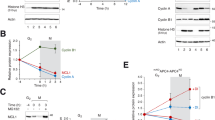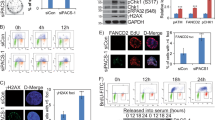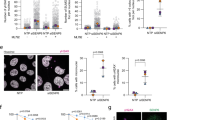Abstract
A number of signalling pathways have been identified that regulate apoptosis, but the mechanism that initiates apoptosis remains incompletely understood. We have found that the nuclear RanGTP level is diminished during the early stages of apoptosis, which correlates with immobilization of RCC1 on the chromosomes. Furthermore, the expression of phosphomimetic histone H2B or caspase-activated Mst1 immobilizes RCC1 and causes reduction of nuclear RanGTP levels, which leads to inactivation of the nuclear transport machinery. As a consequence, nuclear localization signal (NLS)-containing proteins, including NF-κB–p65, remain bound to importins α and β in the cytoplasm. Knocking down Mst1 allows resumption of nuclear transport and the nuclear entry of NF-κB–p65, which have important roles in rescuing cells from apoptosis. Therefore, we propose that RCC1 reads the histone code created by caspase-activated Mst1 to initiate apoptosis by reducing the level of RanGTP in the nucleus.
This is a preview of subscription content, access via your institution
Access options
Subscribe to this journal
Receive 12 print issues and online access
$209.00 per year
only $17.42 per issue
Buy this article
- Purchase on Springer Link
- Instant access to full article PDF
Prices may be subject to local taxes which are calculated during checkout








Similar content being viewed by others
Change history
16 December 2008
In the version of this article initially published online, the bands showing NF-κB-p50 in Figure 1b, and the columns for GFP and mCherry in Figure 5a were incorrectly labelled. The figure 7b legend should also read “...(15, 5, 2 μl)” instead of “...(10, 5, 2 μl).
References
Ahn, S. H. et al. Sterile 20 kinase phosphorylates histone H2B at serine 10 during hydrogen peroxide-induced apoptosis in S. cerevisiae. Cell 120, 25–36 (2005).
Cheung, W. L. et al. Apoptotic phosphorylation of histone H2B is mediated by mammalian sterile twenty kinase. Cell 113, 507–517 (2003).
de Souza, P. M. & Lindsay, M. A. Mammalian Sterile20-like kinase 1 and the regulation of apoptosis. Biochem. Soc. Trans. 32, 485–488 (2004).
Faleiro, L. & Lazebnik, Y. Caspases disrupt the nuclear-cytoplasmic barrier. J. Cell Biol. 151, 951–959 (2000).
Li, H. Y., Wirtz, D. & Zheng, Y. A mechanism of coupling RCC1 mobility to RanGTP production on the chromatin in vivo. J. Cell Biol. 160, 635–644 (2003).
Cushman, I., Stenoien, D. & Moore, M. S. The dynamic association of RCC1 with chromatin is modulated by Ran-dependent nuclear transport. Mol. Biol. Cell 15, 245–255 (2004).
Li, H. Y., Ng, W. P., Wong, C. H., Iglesias, P. A. & Zheng, Y. Coordination of chromosome alignment and mitotic progression by the chromosome-based Ran signal. Cell Cycle 6, 1886–1895 (2007).
Karpinich, N. O., Tafani, M., Rothman, R. J., Russo, M. A. & Farber, J. L. The course of etoposide-induced apoptosis from damage to DNA and p53 activation to mitochondrial release of cytochrome c. J. Biol. Chem. 277, 16547–16552 (2002).
Nomura, M. et al. Apoptotic cytosol facilitates Bax translocation to mitochondria that involves cytosolic factor regulated by Bcl-2. Cancer Res. 59, 5542–5548 (1999).
Ferrando-May, E. Nucleocytoplasmic transport in apoptosis. Cell Death Differ. (2005).
Miyamoto, Y. et al. Cellular stresses induce the nuclear accumulation of importin α and cause a conventional nuclear import block. J. Cell Biol. 165, 617–623 (2004).
Kodiha, M., Chu, A., Matusiewicz, N. & Stochaj, U. Multiple mechanisms promote the inhibition of classical nuclear import upon exposure to severe oxidative stress. Cell Death Differ. 11, 862–874 (2004).
Kihlmark, M. et al. Correlation between nucleocytoplasmic transport and caspase-3-dependent dismantling of nuclear pores during apoptosis. Exp. Cell Res. 293, 346–356 (2004).
Li, H. Y. & Zheng, Y. Phosphorylation of RCC1 in mitosis is essential for producing a high RanGTP concentration on chromosomes and for spindle assembly in mammalian cells. Genes Dev. 18, 512–527 (2004).
Tachibana, T., Imamoto, N., Seino, H., Nishimoto, T. & Yoneda, Y. Loss of RCC1 leads to suppression of nuclear protein import in living cells. J. Biol. Chem. 269, 24542–24545 (1994).
Uchida, S. et al. Premature chromosome condensation is induced by a point mutation in the hamster RCC1 gene. Mol. Cell Biol. 10, 577–584 (1990).
Walther, T. C. et al. The nucleoporin Nup153 is required for nuclear pore basket formation, nuclear pore complex anchoring and import of a subset of nuclear proteins. EMBO J. 20, 5703–5714 (2001).
Kihlmark, M., Imreh, G. & Hallberg, E. Sequential degradation of proteins from the nuclear envelope during apoptosis. J. Cell Sci. 114, 3643–3653 (2001).
Kalab, P., Pralle, A., Isacoff, E. Y., Heald, R. & Weis, K. Analysis of a RanGTP-regulated gradient in mitotic somatic cells. Nature 440, 697–701 (2006).
Wang, Y. et al. Beyond the double helix: writing and reading the histone code. Novartis Found. Symp. 259, 3–21; discussion 17–21, 163–169 (2004).
Glantschnig, H., Rodan, G. A. & Reszka, A. A. Mapping of MST1 kinase sites of phosphorylation. Activation and autophosphorylation. J. Biol. Chem. 277, 42987–42996 (2002).
Ura, S., Masuyama, N., Graves, J. D. & Gotoh, Y. Caspase cleavage of MST1 promotes nuclear translocation and chromatin condensation. Proc. Natl Acad. Sci. USA 98, 10148–10153 (2001).
Fagerlund, R., Kinnunen, L., Kohler, M., Julkunen, I. & Melen, K. NF-κB is transported into the nucleus by importin α3 and importin α4. J. Biol. Chem. 280, 15942–15951 (2005).
Perkins, N. D. NF-κB: tumor promoter or suppressor? Trends Cell Biol. 14, 64–69 (2004).
Karin, M., Cao, Y., Greten, F. R. & Li, Z. W. NF-κB in cancer: from innocent bystander to major culprit. Nature Rev. Cancer 2, 301–310 (2002).
Henkel, T. et al. Rapid proteolysis of IκB-α is necessary for activation of transcription factor NF-κ B. Nature 365, 182–185 (1993).
Bischoff, F. R. & Ponstingl, H. Mitotic regulator protein RCC1 is complexed with a nuclear ras-related polypeptide. Proc. Natl Acad. Sci. USA 88, 10830–10834 (1991).
Bischoff, F. R. & Ponstingl, H. Catalysis of guanine nucleotide exchange on Ran by the mitotic regulator RCC1. Nature 354, 80–82 (1991).
Bischoff, F. R. & Ponstingl, H. Catalysis of guanine nucleotide exchange of Ran by RCC1 and stimulation of hydrolysis of Ran-bound GTP by Ran-GAP1. Methods Enzymol. 257, 135–144 (1995).
Renault, L., Kuhlmann, J., Henkel, A. & Wittinghofer, A. Structural basis for guanine nucleotide exchange on Ran by the regulator of chromosome condensation (RCC1). Cell 105, 245–255 (2001).
Richmond, T. J. & Davey, C. A. The structure of DNA in the nucleosome core. Nature 423, 145–150 (2003).
Komeili, A. & O'Shea, E. K. New perspectives on nuclear transport. Annu. Rev. Genet. 35, 341–364 (2001).
Gorlich, D. & Kutay, U. Transport between the cell nucleus and the cytoplasm. Annu. Rev. Cell Dev. Biol. 15, 607–660 (1999).
Phair, R. D. & Misteli, T. High mobility of proteins in the mammalian cell nucleus. Nature 404, 604–609 (2000).
Misteli, T., Gunjan, A., Hock, R., Bustin, M. & Brown, D. T. Dynamic binding of histone H1 to chromatin in living cells. Nature 408, 877–881 (2000).
Karpova, T. S. et al. Fluorescence resonance engergy transfer from cyan to yellow fluorescent protein detected by acceptor photobleaching using confocal microscopy and a single laser. J. Microscopy 209, 56–70 (2003).
Acknowledgements
This work was supported by Academic Research Fund, Ministry of Education, Singapore (ARC 7/06) and Biomedical Research Council, A*STAR, Singapore (05/1/22/19/388).
Author information
Authors and Affiliations
Contributions
C.H.W. carried out most of the experiments; H.C., C.Y.H., S.K.L. and K.S.C. assisted with some experiments; H.Y.L., C.H.W. and C.G.K. conceived and designed the project; H.Y.L, C.G.K., H.C. and C.H.W. wrote the manuscript. All authors participated in data analysis. All authors read and edited the manuscript.
Corresponding authors
Ethics declarations
Competing interests
The authors declare no competing financial interests.
Supplementary information
Supplementary Information
Supplementary Information (PDF 1174 kb)
Rights and permissions
About this article
Cite this article
Wong, CH., Chan, H., Ho, CY. et al. Apoptotic histone modification inhibits nuclear transport by regulating RCC1. Nat Cell Biol 11, 36–45 (2009). https://doi.org/10.1038/ncb1810
Received:
Accepted:
Published:
Issue Date:
DOI: https://doi.org/10.1038/ncb1810
This article is cited by
-
5-Flurouracil disrupts nuclear export and nuclear pore permeability in a calcium dependent manner
Apoptosis (2017)
-
Mitosis-targeted anti-cancer therapies: where they stand
Cell Death & Disease (2012)
-
Regulation of NF-κB signaling by caspases and MALT1 paracaspase
Cell Research (2011)
-
Survivin withdrawal by nuclear export failure as a physiological switch to commit cells to apoptosis
Cell Death & Disease (2010)
-
Cracking the death code: apoptosis-related histone modifications
Cell Death & Differentiation (2010)



